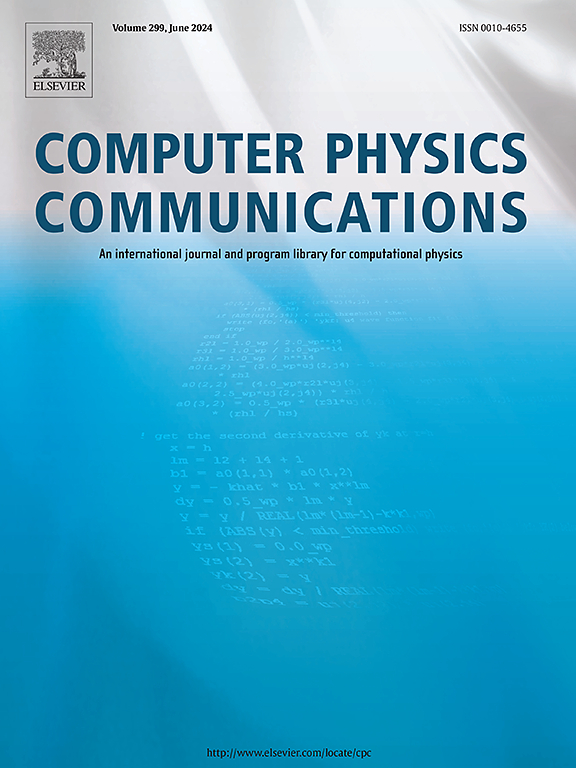PARPHOM: PARallel PHOnon calculator for Moiré systems
IF 3.4
2区 物理与天体物理
Q1 COMPUTER SCIENCE, INTERDISCIPLINARY APPLICATIONS
引用次数: 0
Abstract
The introduction of a twist between two layers of two-dimensional materials has opened up a new and exciting field of research known as twistronics. In these systems, the phonon dispersions show significant renormalization and enhanced electron-phonon interactions as a function of the twist angle. However, the large system size of the resulting moiré patterns in these systems makes phonon calculations computationally challenging. In this paper, we present PARPHOM, a powerful code package designed to address these challenges. PARPHOM enables the generation of force constants, computation of phononic band structures, and determination of density of states in twisted 2D material systems. Moreover, PARPHOM provides essential routines to investigate the finite temperature dynamics in these systems and analyze the chirality of the phonon bands. This paper serves as an introduction to PARPHOM, highlighting its capabilities and demonstrating its utility in unraveling the intricate phononic properties of twisted 2D materials.
Program summary
Program Title: PARPHOM
CPC Library link to program files: https://doi.org/10.17632/gp6rzrp47m.1
Developer's repository link: https://github.com/qtm-iisc/PARPHOM
Licensing provisions: GNU General Public License v3.0
Programming language: FORTRAN, Python
External Routines/libraries: numpy, LAMMPS (serial Python wrapper), mpi4py, ScaLAPACK, HDF5, matplotlib, scipy, Spglib
Nature of problem: Due to the large number of atoms in 2D moiré systems, performing phonon calculations is quite challenging. The exorbitantly high memory requirements of such calculations make them infeasible with currently available codes.
Solution method: A parallel algorithm to generate the force constant matrices for these large moiré systems has been implemented. Parallel diagonalization routines available in ScaLAPACK are then used to diagonalize the dynamical matrices constructed from the force constants at each q points.
用于监控系统的并行声子计算器
在两层二维材料之间引入扭曲,开辟了一个新的令人兴奋的研究领域,即扭曲电子学。在这些系统中,声子色散表现出显著的重整化和增强的电子-声子相互作用作为扭转角的函数。然而,在这些系统中产生的moir模式的大系统尺寸使得声子计算在计算上具有挑战性。在本文中,我们介绍了parphm,一个强大的代码包,旨在解决这些挑战。PARPHOM可以生成力常数,计算声子带结构,并确定扭曲二维材料系统中的态密度。此外,PARPHOM为研究这些系统的有限温度动力学和分析声子带的手性提供了必要的程序。本文作为对PARPHOM的介绍,强调了它的能力,并展示了它在解开扭曲二维材料的复杂声子特性方面的效用。程序摘要程序标题:PARPHOMCPC库链接到程序文件:https://doi.org/10.17632/gp6rzrp47m.1Developer's存储库链接:https://github.com/qtm-iisc/PARPHOMLicensing条款:GNU通用公共许可证v3.0编程语言:FORTRAN, Python外部例程/库:numpy, LAMMPS(串行Python包装器),mpi4py, ScaLAPACK, HDF5, matplotlib, scipy, spglib问题性质:由于二维声子系统中存在大量的原子,因此进行声子计算是相当具有挑战性的。这种计算对内存的要求过高,这使得它们在当前可用的代码中是不可行的。求解方法:给出了一种求解这些大型运动系统的力常数矩阵的并行算法。然后使用ScaLAPACK中可用的并行对角化例程对由每个q点的力常数构造的动态矩阵进行对角化。
本文章由计算机程序翻译,如有差异,请以英文原文为准。
求助全文
约1分钟内获得全文
求助全文
来源期刊

Computer Physics Communications
物理-计算机:跨学科应用
CiteScore
12.10
自引率
3.20%
发文量
287
审稿时长
5.3 months
期刊介绍:
The focus of CPC is on contemporary computational methods and techniques and their implementation, the effectiveness of which will normally be evidenced by the author(s) within the context of a substantive problem in physics. Within this setting CPC publishes two types of paper.
Computer Programs in Physics (CPiP)
These papers describe significant computer programs to be archived in the CPC Program Library which is held in the Mendeley Data repository. The submitted software must be covered by an approved open source licence. Papers and associated computer programs that address a problem of contemporary interest in physics that cannot be solved by current software are particularly encouraged.
Computational Physics Papers (CP)
These are research papers in, but are not limited to, the following themes across computational physics and related disciplines.
mathematical and numerical methods and algorithms;
computational models including those associated with the design, control and analysis of experiments; and
algebraic computation.
Each will normally include software implementation and performance details. The software implementation should, ideally, be available via GitHub, Zenodo or an institutional repository.In addition, research papers on the impact of advanced computer architecture and special purpose computers on computing in the physical sciences and software topics related to, and of importance in, the physical sciences may be considered.
 求助内容:
求助内容: 应助结果提醒方式:
应助结果提醒方式:


